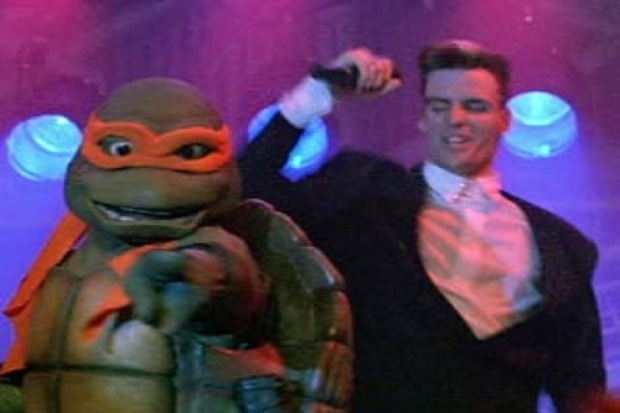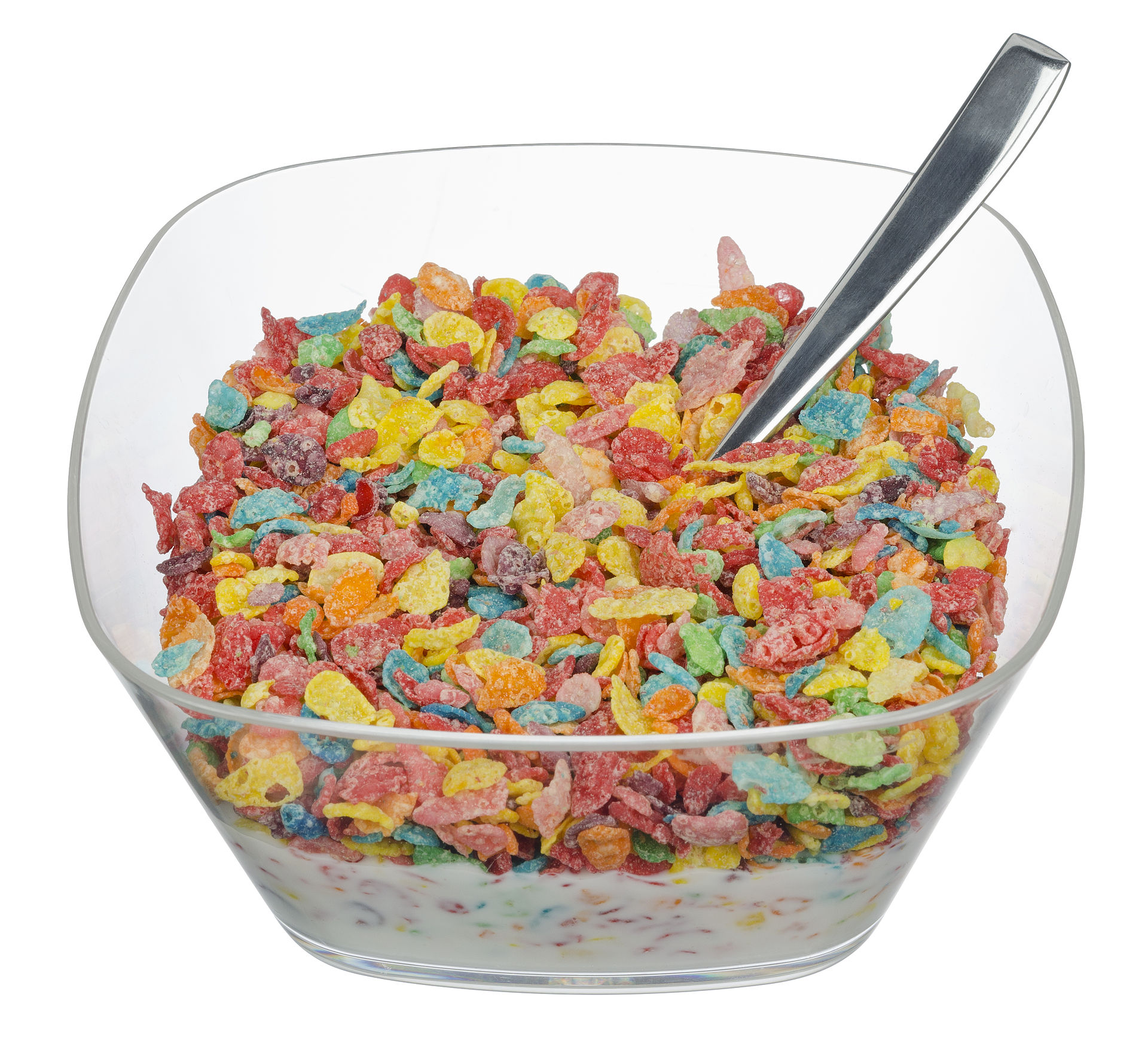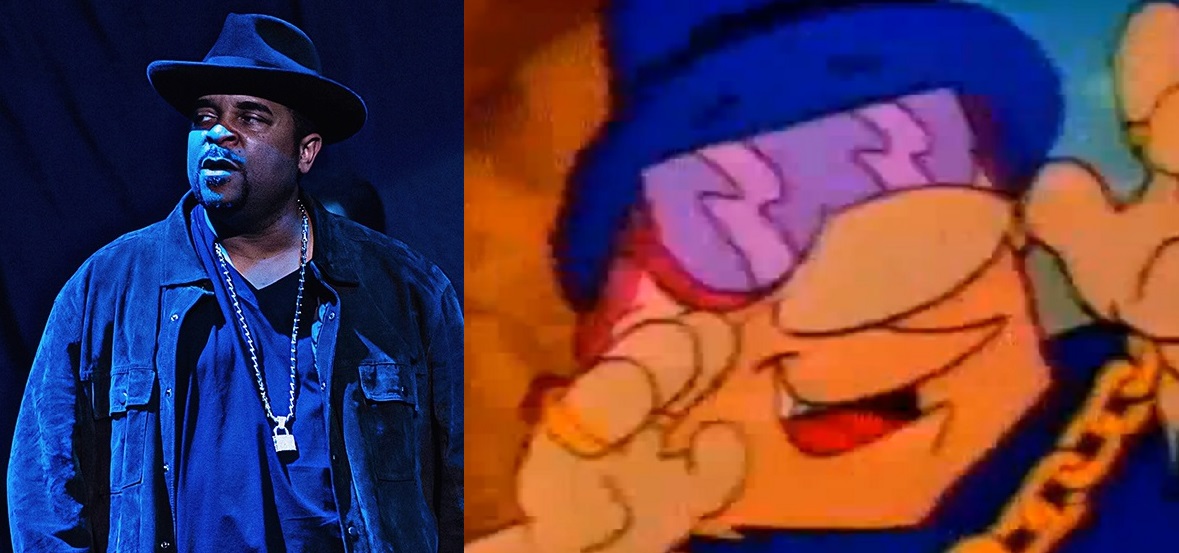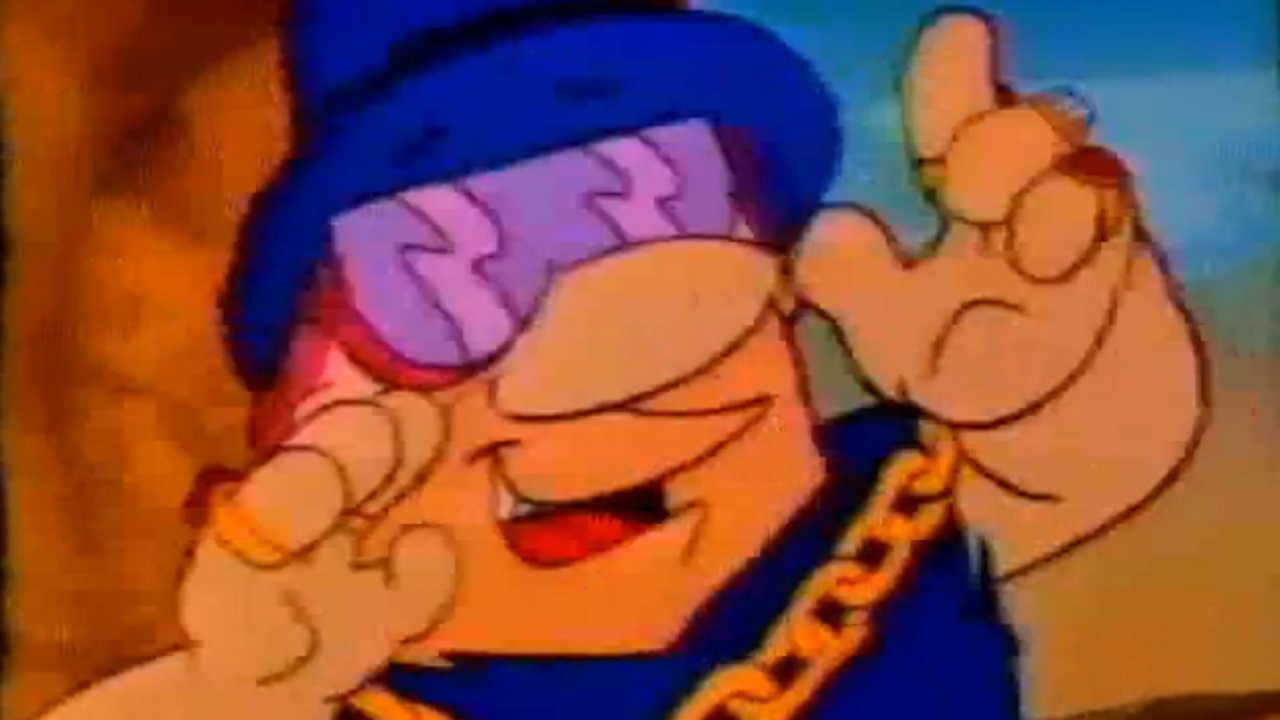Do you want to know what’s been in my head for the past twenty-five years? Because I’m about to tell you what’s been in my head for the past twenty-five years, and if you don’t want to know, stop reading right now; it may never leave you. Well actually, there are three things. Three musical compositions that I find swirling around in my mind whenever nothing else happens to be going on in there. In chronological order they are: one, the “Ground Theme” from Super Mario Bros. Two, the theme from The Simpsons. And the third is this beauty:
For a thirty-second breakfast cereal commercial, there’s a shocking amount of stuff going on here. So in the interest of maybe exorcising it from my brain by cramming it into yours, join me as I overthink exactly what the hell is going on here.
The Master Rapper
First things first: clearly this commercial emerged in a world where rap as a genre was already well-enough established in the mainstream that it seemed not only safe but smart for a breakfast cereal company to use it as a vector to derive profit by convincing children to associate rap music with their product. In other words, rap is “cool” – meaning that it’s beloved by eleven-year-olds – and therefore seeing a character from a thirty-year-old animated sitcom hipping and hopping on Saturday morning TV is like granting a license for Post Cereals to print money.
The context of the commercial is this: it’s 1992. We’re already a couple of years past the point where the market has discovered the perfect balance of threatening and unthreatening to get rap to appeal to children by confounding and annoying their parents while going easy on the sociological imagery of disenfranchised black youth in the American inner-cities that would have no resonance with the mostly white suburban audience that had access to some serious album-buying money. What we’re talking about is a post-Vanilla Ice world. Of course it’s not like Vanilla Ice was the first “commercial” rapper, or the first white rapper, or the first person to make rap available to bourgeois tweens. But his 1990 debut single “Ice Ice Baby” was the tipping point, beyond which it became possible to talk sensibly about selling rap to kids without having to worry about any inherent associations between rap as a genre and violence, sex, or even swearing.
Parents and their kids both had a context for understanding rap as a solidly mainstream phenomenon, not only because of Vanilla Ice but through The Fresh Prince of Bel Air, wherein Will Smith’s rap persona was paired with an extremely wholesome (though not entirely socially unaware) sitcom that could be watched together as a family.

Vanilla Ice (with Ninja Turtle, for scale)
At the time this commercial came out, kids my age (so, around 12-13) were well aware of rap through nonthreatening singles from Vanilla Ice and Fresh Prince, as well as MC Hammer, Kris Kross, and others. We’d even moved on to edgier stuff, like Naughty By Nature’s “O.P.P.”, Black Sheep’s “The Choice is Yours,” House of Pain’s “Jump Around,” and, of course, “Baby Got Back” by the immortal Sir Mix-a-Lot. Even if we could barely discern one word out of twenty, we knew the songs themselves and where they lived in the culture.
So the next logical step, of course, was Fruity Pebbles.
In the wake of Vanilla Ice, it was goofy but also laughably plausible for Barney Rubble to don the guise of “The Master Rapper” as a scheme to gain fraudulent access to Fred Flintstone’s strategic breakfast cereal reserves.
The Political Economy of Late Capitalist Breakfast Cereal
Now, I’m sure that this has been discussed many times before, but it’s worth another go-round, I think: what the hell was going on with the cereal market in the late 80s? An astounding proportion of the advertising for this stuff hinged upon dissimulation and outright theft. For no explicable reason, sugary cereals were a scarce resource – in some cases an anthropocentric infantocracy deliberately prevented non-human non-children from acquiring it; in other cases, they actually robbed and deprived the individual of his own (presumably) legitimately-acquired cereal so they could have it for themselves. Look, we all know that children are little sociopaths who will do anything for one marshmallow. So while these depraved acts of intimidation and thievery are morally reprehensible – and, hopefully, have cost those kids dearly in therapy bills as they grew up and realized what kind of monsters they had been[1] – they’re also, in a sense, comprehensible.
This thing with the Fruity Pebbles, though, was something different. Fred Flintstone and Barney Rubble, were, ostensibly, equals. Comparable in age, social and economic class, and basically every discernible category. Clearly it wasn’t the case that Barney was being deprived of his rightful share of a cereal to which he was desperately addicted (as was the Trix Rabbit). A more apt comparison would seem to be with Lucky the Leprechaun; from a certain perspective, you can almost see the logic of these kids wanting to take his Lucky Charms, in a “empty carbohydrates want to be free” kind of way – it’s not implausible to read these commercials as strongly implying that Lucky was the only source of Lucky Charms available anywhere, and the kids relieving him of them (note that he always has plenty more the next time) was seen as a kind of Saturday morning bread riot, with the youth rising up and seizing, if not the means of production, then at least the fruits of that production. Or froots, anyway. Whatever those are.
But in the case of Fruity Pebbles, this obviously is not what’s happening. If Fred can afford to go out and buy them, then so can Barney. Yet he doesn’t. The most obvious explanation for this behavior is that Barney is just doing all this for shits and giggles – he’s like a prehistoric Loki, engaging in ridiculously convoluted schemes in order to trick and irritate his friend, rather than because he wants the cereal qua cereal. In other words, it’s not so much that Barney wants Fruity Pebbles, but rather he wants Fred’s Fruity Pebbles in particular. Just, as the kids say, “for the lulz.”
Unfortunately, this hypothesis fails. And the reason that it fails is detailed within this commercial itself; we’ll get more deeply into the lyrics of Barney’s song a bit later, but toward the end of the rap, Barney admits “to get that fruity taste, [he’s] got to trick Fred.” Of course, uttering this line is what clues Fred in, finally, to the fact that he’s been fooled into giving away his precious cereal. But by that point, Barney no longer cares: he’s already got what he wanted, the ruse has succeeded. While Barney obviously enjoys what he’s doing – he implores us, the viewers, at the beginning of the commercial to watch him get Fred’s Fruity Pebbles, laughing with malicious glee – it doesn’t seem like his plan is solely based on the fact that it’s more fun to steal Fred’s cereal than it would be to buy some from the store. He doesn’t say, “to get that fruity taste, I like to trick Fred,” or “it’s dope to trick Fred.” He’s got to trick Fred.” If Barney wants them, he must trick Fred: he can’t obtain the Pebbles in any legitimate fashion, and Fred refuses to share them with him (another bizarre cereal commercial trope that has long gone unstudied and unexplained).
Why would this be? What exactly is it about the cereal ecosystem that lends it so overwhelmingly to this penetrating, mysterious scarcity? We can’t rule out the possibility that Barney has simply been banned from the supermarket for being such a jerk. Maybe this ban extends to his wife as well, so that Betty can’t just go and pick up some Fruity Pebbles for her husband either – but then, where do the Rubbles get the rest of their food? Clearly they’re not hunting and/or gathering it. For all its prehistoric trappings, the Flintstones and the other citizens of Bedrock are quite explicitly a modern stone age family. This is post-agriculture; the Flintstones obviously aren’t following the Paleo diet. The whole question depends upon the cultivation of grains, after all.

The entirety of this incomplete breakfast
In fact, there’s no evidence at all that Fruity Pebbles (or, for that matter, Cocoa Pebbles) are even available anywhere except the Flintstone residence. My hypothesis is this: Fruity Pebbles is diegetically artisanal. Fred himself must be harvesting, grinding, and processing the cereal in some kind of hipster habilis micro-cerealry. Maybe he even documents and shares the process via Flintstagram. I don’t know. But it makes sense. Think about it: the cereal is even named after his daughter.
This solves pretty much all the problems with the scenario. Fred makes the cereal himself. Barney loves it. He can’t just buy it at the store, and he also enjoys irritating his neighbor. I can easily see Barney as the kind of person who ceaselessly teases Fred for making his own cereal at home – this is why he won’t just admit that he wants some and pay Fred to obtain some – and so he kills two pterodactyls with one… stone… by tricking Fred into relinquishing his grasp on the cereal in the guise of a prank; Barney gets to eat his Pebbles and have them too.
The Actual Song
Regardless of its persistence through the decades, Barney’s rap only actually has two lines. A pair of rhyming couplets that have burrowed their way into the collective memory of a generation. Or at least into my own, personal memory, which my generational narcissism leads me to universalize.
The first line, “I’m the Master Rapper and I’m here to say / I love Fruity Pebbles in a major way,” clearly signals the functionality of early rap’s introductory phrases. I’m not going to go into the history of the “I’m Something Something and I’m Here to Say” lyrical trope, because The Village Voice has already done an admirable job of that. I’ll just note that here, the line serves to answer Fred’s question (“Who are you?”), introduce the premise of the charade, while making it impossibly obvious to all viewers that Barney is attempting to locate himself within the context of rap and rapper culture. In case the Sir Mix-a-Lot cosplay didn’t clue you in.

It’s the second half of the song that’s haunted me for all these years. It goes like this:
“They’re Bedrock yellow, orange, purple, lime, and red / But to get that fruity taste, I’ve got to trick Fred.”
Read that again. Do you notice what’s wrong with it?
Yellow. Orange. Purple. LIME. And red.
Barney mentions four of the colors of the cereal. And then one of the flavors.
WHY? Why the hell would he do that?? This has been bugging me for literally the majority of my life. The last word of that line needs to be “red,” so that it can rhyme with “Fred.” Fine. So why – why on Earth – would you just throw “lime” in there??? The scansion would have been completely unaffected by substituting the color “green” for the fruit “lime!” What possible reason could there be to include the names of four colors and then one flavor? Arguably, “orange” could refer to the flavor rather than the colour, but I doubt it. Then you need to explain why Barney alternates between colors and flavors, and that’s at least as inextricable a problem. You can also argue that “lime” can be construed as the name of a color. Sure, but is “lime” such a distinct shade from the generic “green” as represented in the physical incarnation of these particular pieces of cereal? If you described this one Fruity Pebble to someone as being “green,” would anyone in the world respond, “That’s not green, it’s lime-colored”???
No! Of course not! I don’t care if you’re the most tetrachromatic person in the whole world (which I can guarantee you that Barney Rubble is not, because only women have that trait). You can have twenty million extra cones in your vitreous humour and be the most pedantic pedant who ever pedanted, I guarantee that nobody is going to prefer “lime” to “green” if “yellow,” “orange,” “purple,” and “red” are acceptable to them. It doesn’t make any sense!
So what gives? Huh? What gives, Post Cereals? What were you thinking? What could you possibly have been thinking?? Why did you do this?? Why did you do this to me???

[1] Actually, that would be a great commercial: twenty-five years later, all those kids, grown up and repentant, get together to apologize to the victims of their bullying and beg for forgiveness, and pitch in to donate a lifetime supply of cereal as a gesture of atonement. That’s some Don Draper level media right there.
The more disturbing explanation for the phenomena you describe is that Pebbles herself – the namesake of the serial – is in some way a necessary condition for the production of Fruity Pebbles. Since she lives in Fred’s house, that where you have to go to get it. I will not dare speculate about the procedure for generating Fruity Pebbles, and refuse to even think about Cocoa Pebbles. I have to assume that prehistoric laws about child labor and the exploitation of minors were more lax. We should also remember that the True Pebbles are probably quite different from the compromised commercial version fit for mass production.
One possible explanation for the lime/green issue. Green was added as a new flavor in 1987 (scroll down to “product evolution for the source https://en.wikipedia.org/wiki/Pebbles_cereal#Television_commercials ) and it was the most recent “new” flavor when this commercial aired in 1992. Perhaps, even though the flavor was 5 years old at that point, it was still a recent enough addition that for branding purposes it was officially called lime to differentiate it from its forebears?
Now I really want to find transcriptions of earlier pebbles commercials to see if it’s consistently referred to as lime, but alas, Google searches for “flintstones pebbles commercials lyrics” only return rappin’ Barney and the Christmas one, which has the line “ho ho ho I’m hu-hu-hungry” and will now be stuck in my head for the next three years.
I think the point you hit on about breakfast cereal scarcity is part of a much broader phenomenon of food advertisement very prevalent around that time ( and which still exists, actually), the competition for food, especially within families or friend groups.
I remember this because when my parents saw them, they’d express their disgust at these commercials. They didn’t talk about them in terms of bad taste, or just not funny, they genuinely found them morally objectionable. In fact, they saw it as one of the things that was troubling about American culture as a whole (we had just moved here around that time). Granted, my family has a particularly odd attitude towards generosity and sharing, especially around food and family. Our meals usually end in arguments over who’ll take the last piece. With everyone trying convincing the rest of the family that they DON’T want it.
Anyway, this has led to a bit of a hyperawareness on my part to this kinds of commercial. The biggest offender, of course, were the “leggo my eggo” ones. Much like the Fruity Pebbles commercials, it seemed like people could only eat these frozen “waffles” if they’d been stolen. Except in this case it was obvious that they weren’t artisanal. In most of the scenarios were someone beseeched someone else to “leggo my eggo,” there was probably a whole box of them in the freezer. And often times it would be a child stealing it from a parent. Why couldn’t the kid just ask the parent to put another one in the toaster for them? What kind of parent wouldn’t happily do their child that favor?
Of course, from what I recall, most of these intrafamily struggles for resources were set in nice middle class homes. Maybe if they had been in families of obviously lower economic class, the kind of objections my parents had towards this kind of marketing would have been more widely shared?
Here’s one Eggo commercial that is a good illustration.
https://www.youtube.com/watch?v=MEoHR_aPO2M
And here’s a Corn Pops commercial aimed at teenagers whose message seems to be “Corn Pops are so important, they’re worth ruining your brother’s lame breakfast dates for them.”
https://www.youtube.com/watch?v=luFmdbaglMc&list=PLaYFSe-nonv1DCe2r7DZg7Sd03DqEPqxT&index=10
And completely off topic: while looking for these, I found a preview of a blatant Babe rip-off that really makes clear that the 90’s were a golden age for talking animal movies.
https://www.youtube.com/watch?v=RSTZl1bENrc
“Our meals usually end in arguments over who’ll take the last piece. With everyone trying convincing the rest of the family that they DON’T want it.”
Off-topic, but you’re from Minnesota, aren’t you? ;D
Nope. Actually have never been there.
I did, technically grow up in the midwest though, since when we moved to the states we moved to the ‘burbs of Chicago.
But, I was born ( and my parents grew up in) a South American country famous for having loud, rude, arrogant citizens (we also swear a lot, which is a trait I definitely ended up with). I have no idea which parts of which cultures have led to how my family acts around the dinner table.
This idea may not be sufficiently overthought, but I am imagining that cereal manufacturers are actively trying to undermine good parenting by encouraging children to throw tantrums in the cereal aisle.
This thought begins with that shot from “The Hurt Locker” at the end where he is standing in the endless and immaculate cereal aisle. So many choices and all of them nonsensical, after just having endangered your life and hoping to live another day (at least that’s what I imagine the scene is implying). And if you think about the actual contents of those aisles, the choices are basically sugary grain or not sugary grain. If we take it as given that the non-sugary grain is for adults and the sugary grain is for children, then there are still way too many choices. And add to this that children are not food connoisseurs. We have a situation where the parents will only buy unhealthy sugary cereal if asked, and kids have very few tools with which to distinguish the various cereals to make a recommendation to their parents. On top of this, children will often like things because they are told to (or like them because they are told not too), so these are the constraints within which the cereal companies have to operate.
So we see commercials with fun cartoon authority figures that have cereal and like having cereal. We also get child protagonists (0r cartoon characters we are supposed to relate to, like Barney) who want cereal and don’t have cereal. Then non-malicious hijinks ensue which allow the protagonist to get cereal from the authority figure without money.
So we see that the children are being taught to throw tantrums/cause problems for their authority-figure parents in order to get the cereals that they think is the best (which probably means has the best cartoon mascot) because children have no money and there are a lot of undifferentiated (to children) choices. The commercials forward a narrative in which the problem causer gets what they want, giving the child a history of seeing that throwing tantrums will get you what you want, and therefore increasing their likelihood of sitting on the floor crying in the cereal aisle until they get their Fruity Pebbles.
I think this is a good read.
When I was looking for commercials to use as examples for my comment above, I noticed that a lot of them had not just a “take food from people” vibe, but also a real anti-authority vibe. I think you’re idea could definitely be possible.
Another possibility is that as a child and adolescent, where one is surrounded and constrained by authority figures, being someone who can break or bend the rules and get away with it reads as cool. So by stealing Barney and the lucky charms kids are cool and the eggo kids are cool b/c they are in competition with their parents, the Trix kids are cool because they refuse to share, which kids are always told what to do. (This last one might not hold up as much)
This was hilarious. I especially appreciated “Flintstagram” because I’m easily amused.
This commercial originated in the late 1980s, not 1992.
This thinkpiece made me laugh SO hard, so thank you for this. I was just telling my husband last night that, for no reason at all, I’ve had this Fruity Pebbles rap stuck in my head for weeks. I haven’t seen it in 30 years, but I remembered all the words – EXCEPT, in a case of the Mandela effect, I suppose, I had remembered the lyrics as “the Bedrock yellow, orange, purple, GREEN, and red.” When I googled this ad to show him, since he had no memory of this song whatsoever, I was shocked – SHOCKED! – that it was “lime.” I have a near-perfect recall on song lyrics generally, and this floored me. Add in the confusion you felt about why it’s the only fruit explicitly named in the list, and it was definitely an unnerving moment.
Anyway, I am grateful that I’m not the only person who still inexplicably lets this ad occupy real estate in my head for free 3 decades later.